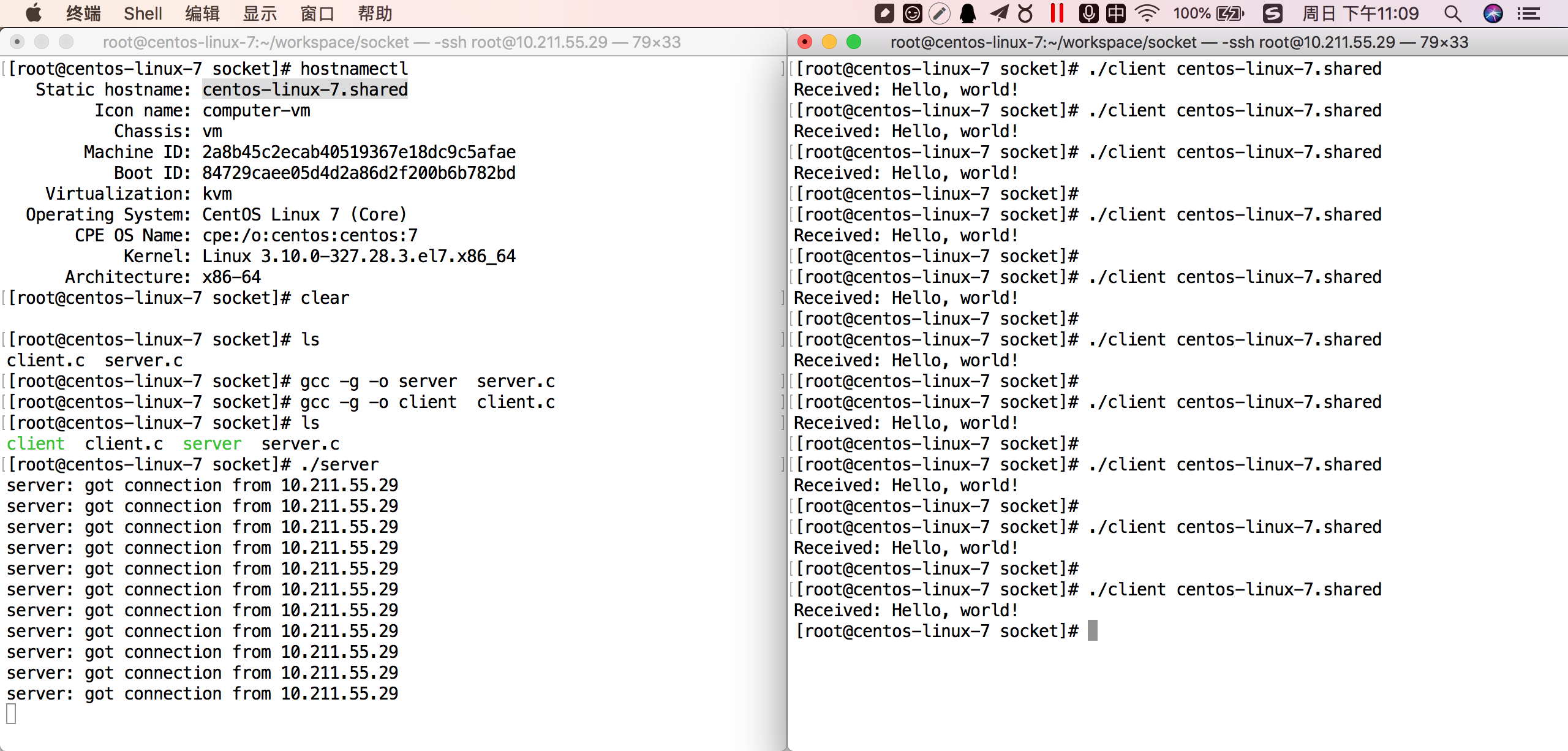刷微博看到有人推荐了一篇国外讲网络编程的文章,有时间学习了下,现将部分内容整理如下已备复习查阅。
服务端:
server.c
/*
** server.c -- a stream socket server demo
*/
#include <stdio.h>
#include <stdlib.h>
#include <unistd.h>
#include <errno.h>
#include <string.h>
#include <sys/types.h>
#include <sys/socket.h>
#include <netinet/in.h>
#include <arpa/inet.h>
#include <sys/wait.h>
#include <signal.h>
#define MYPORT 3490 // the port users will be connecting to
#define BACKLOG 10 // how many pending connections queue will hold
void sigchld_handler(int s)
{
while(waitpid(-1, NULL, WNOHANG) > 0);
}
int main(void)
{
int sockfd, new_fd; // listen on sock_fd, new connection on new_fd
struct sockaddr_in my_addr; // my address information
struct sockaddr_in their_addr; // connector's address information
socklen_t sin_size;
struct sigaction sa;
int yes=1;
if ((sockfd = socket(AF_INET, SOCK_STREAM, 0)) == -1) {
perror("socket");
exit(1);
}
if (setsockopt(sockfd, SOL_SOCKET, SO_REUSEADDR, &yes, sizeof(int)) == -1) {
perror("setsockopt");
exit(1);
}
my_addr.sin_family = AF_INET; // host byte order
my_addr.sin_port = htons(MYPORT); // short, network byte order
my_addr.sin_addr.s_addr = INADDR_ANY; // automatically fill with my IP
memset(my_addr.sin_zero, '\0', sizeof my_addr.sin_zero);
if (bind(sockfd, (struct sockaddr *)&my_addr, sizeof my_addr) == -1) {
perror("bind");
exit(1);
}
if (listen(sockfd, BACKLOG) == -1) {
perror("listen");
exit(1);
}
sa.sa_handler = sigchld_handler; // reap all dead processes
sigemptyset(&sa.sa_mask);
sa.sa_flags = SA_RESTART;
if (sigaction(SIGCHLD, &sa, NULL) == -1) {
perror("sigaction");
exit(1);
}
while(1) { // main accept() loop
sin_size = sizeof their_addr;
if ((new_fd = accept(sockfd, (struct sockaddr *)&their_addr, &sin_size)) == -1) {
perror("accept");
continue;
}
printf("server: got connection from %s\n",inet_ntoa(their_addr.sin_addr));
if (!fork())
{ // this is the child process
close(sockfd); // child doesn't need the listener
if (send(new_fd, "Hello, world!\n", 14, 0) == -1)
perror("send");
close(new_fd);
exit(0);
}
close(new_fd); // parent doesn't need this
}
return 0;
}
客户端:
client.c
/*
** client.c -- a stream socket client demo
*/
#include <stdio.h>
#include <stdlib.h>
#include <unistd.h>
#include <errno.h>
#include <string.h>
#include <netdb.h>
#include <sys/types.h>
#include <netinet/in.h>
#include <sys/socket.h>
#define PORT 3490 // the port client will be connecting to
#define MAXDATASIZE 100 // max number of bytes we can get at once
int main(int argc, char *argv[])
{
int sockfd, numbytes;
char buf[MAXDATASIZE];
struct hostent *he;
struct sockaddr_in their_addr; // connector's address information
if (argc != 2) {
fprintf(stderr,"usage: client hostname\n");
exit(1);
}
if ((he=gethostbyname(argv[1])) == NULL) { // get the host info
herror("gethostbyname");
exit(1);
}
if ((sockfd = socket(AF_INET, SOCK_STREAM, 0)) == -1) {
perror("socket");
exit(1);
}
their_addr.sin_family = AF_INET; // host byte order
their_addr.sin_port = htons(PORT); // short, network byte order
their_addr.sin_addr = *((struct in_addr *)he->h_addr);
memset(their_addr.sin_zero, '\0', sizeof their_addr.sin_zero);
if (connect(sockfd, (struct sockaddr *)&their_addr, sizeof their_addr) == -1) {
perror("connect");
exit(1);
}
if ((numbytes=recv(sockfd, buf, MAXDATASIZE-1, 0)) == -1) {
perror("recv");
exit(1);
}
buf[numbytes] = '\0';
printf("Received: %s",buf);
close(sockfd);
return 0;
}
gcc -g -o client client.c
gcc -g -o server server.c
然后服务端执行./server
在开一个终端在centos中首先要使用hostnamectl查询hostname.
较之前没注意的一个点是gethostbyname出错时需要用herror来打印具体出错信息,使用perror只会打印success,原因是gethostbyname出错时会设置h_errno,不会设置errno.
